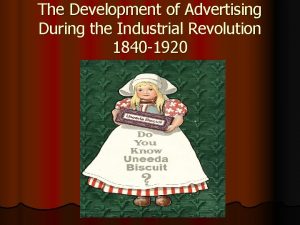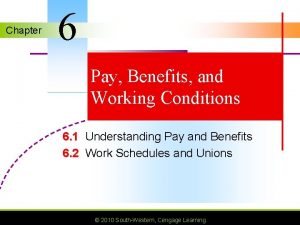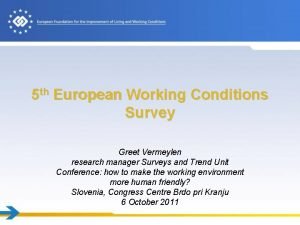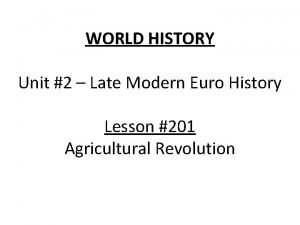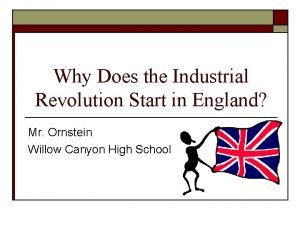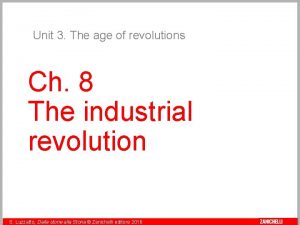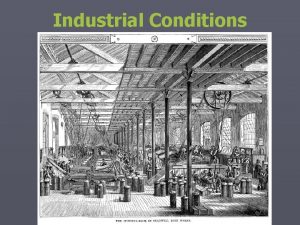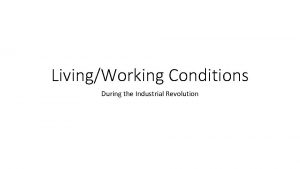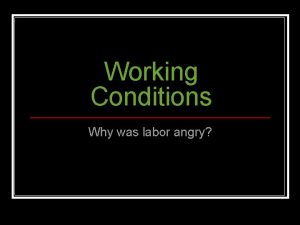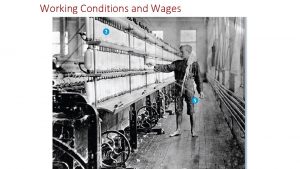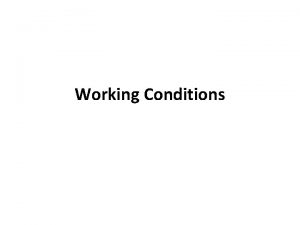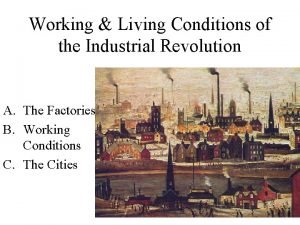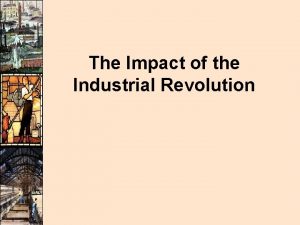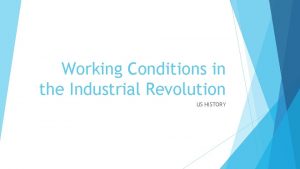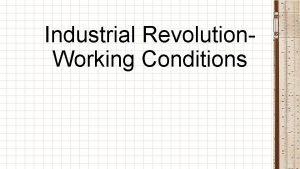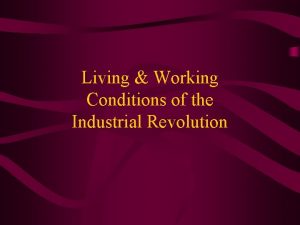Working Conditions During the Industrial Revolution Effect of























- Slides: 23

Working Conditions During the Industrial Revolution

Effect of Industrial Revolution Shifting away from farming and building factories People moving from the rural to urban areas. Specialized labour Inventions lead to machine based production No labour laws lead to poor working conditions

Migration in Hope of Better Life The main reason for moving was to find work. On one hand this involved migration from the countryside to the growing industrial cities, on the other it involved movement from one country to another.

Migration in Hope of Better Life. Cont The British at the time controlled a massive empire including America, Canada, South Africa and Australia so people from these courtiers moved to Britain in search of better life People moving for financial and economic reason, looking to increase their standard of living

What is a Standard of Living Standard of living = standard of living: quality of life measured by general level of consumption of material goods. The more a person can afford to buy the better their stand of living is.

The change in the nation’s demography was highlighted by the gradual move away from an agriculturally-based rural economy towards an industrial, urban one. This mass migration saw towns such as Liverpool, Birmingham and Manchester become thriving working cities.

Demographic Changes �Britain population grew from 8. 7 million to 16. 8 million from 18011851, which is a 193% increase over 50 years. �Increase is due to: 1. Increased life expectancy 2. Increased fertility – longer years of marriage more children � Population growth was accompanied by urbanization. More people living in large cities as oppose to rural areas

The Big Question A lot of historian debate this question Whether an expanding population resulted in economic growth or vice versa, ie was industrialisation a catalyst for population growth? What do you think?

Industry Structure �Specialization of labour�Different branches each one is responsible for a part of the production or business functions. Factories and Business operate similar today. We have customer service, tech department, HR and more �Each branch is

Less people needed to run the same operation as the machine does most of the work. Employees to run machines, supervise and do quality control The division of labour meant that skills were lost and pay was lowered

Working Conditions During the Industrial Revolution in 1802, the movement of people away from their tradition agriculture into industrial cities brought great stress to many people in the work force. This brought stress especially to women. Women in households who had earned income from spinning found that the new factories were taking away their only source of income. Traditional handloom weavers could no longer compete with the mechanized production of cloth.

Skilled labourers sometimes lost their jobs as new machines replaced them. In the factories, people had to work long hours under harsh conditions. Factory owners and managers paid the minimum amount necessary for a work force, often recruiting women and children to tend the machines because they could be hired for a much lower wage. Soon, critics attacked this exploitation, particularly the

The role of workers changed as a result of the division of labour, an idea important to the Industrial Revolution that called for dividing the production process into basic, individual tasks, time of goods produced. Each worker would then perform one task, rather than a single worker doing the entire job.

Such division of labour greatly improved productivity, but many of the simplified factory jobs were repetitive and very boring. Workers also had to labour for many hours, often more than 12 hours a day, sometimes more than 14, and people worked six days a week. Factory workers faced strict rules and close supervision by managers and overseers.

As production moved from the household to factories and people became dependent on labour wages the wages earned by the husband were no longer sufficient to support the family so children and women were forced to work. Factories were overcrowded, terrible living conditions, lack of sanitisation.

The Sadler Report Summarize the working conditions outline in the report. Page 209 in the text book

http: //www. youtube. com/watch? v=MHdma. FJ 6 W 6 M

Role of Women during the Industrial Revolution �The Industrial Revolution in part was fuelled by the economic necessity of many women, single and married, to find waged work outside their home. �Women mostly found jobs in domestic service, textile factories, and piece work shops. They also worked in the coal mines. �For some, the Industrial Revolution provided independent wages, mobility and a better standard of living. For the majority, however, factory work resulted in a life of hardship.

Women worked while they were single but left regular wage employment after marriage especially once they had children. The role of women did not change much their tasks were to keep the house clean, prepare food and care for the children. However, the need to cheap labour gave women the right to work. Which provided some women financial independence

Testimonials of coal workers � Six year old girl: "I have been down six weeks and make 10 to 14 rakes a day; I carry a full 56 lbs. of coal in a wooden bucket. I work with sister Jesse and mother. It is dark the time we go. " � Jane Peacock Watson. "I have wrought in the bowels of the earth 33 years. I have been married 23 years and had nine children, six are alive and three died of typhus a few years since. Have had two dead born. Horse-work ruins the women; it crushes their haunches, bends their ankles and makes them old women at 40. " � Maria Gooder "I hurry for a man with my sister Anne who is going 18. He is good to us. I don't like being in the pit. I am tired and afraid. I go at 4: 30 after having porridge for breakfast. I start hurrying at 5. We have dinner at noon. We have dry bread and nothing else. There is water in the pit but we don't sup it. "

�Mary and Rachell Enock, ages 11 and 12 years. "We are door-keepers in the four foot level. We leave the house before six each morning and are in the level until seven o'clock and sometimes later. We get 2 p a day and our light costs us 2 1/2 p. a week. Rachel was in a day school and she can read a little. She was run over by a tram a while ago and was home ill a long time, but she has got over it. " �Isabel Wilson, 38 years old. "I have been married 19 years and have had 10 bairns [children]: . . . My last child was born on Saturday morning, and I was at work on the Friday night. . . None of the children read, as the work is no regular. . When I go below my lassie 10 years of age keeps house. . . "

General Finding of Working Conditions Working conditions were often unsanitary and the work dangerous. Education suffered because of the demands of work. Home life suffered as women were faced with the double burden of factory work followed by domestic chores and child care.

Men assumed supervisory roles over women and received higher wages. Unsupervised young women away from home generated societal fears over their fate. As a result of the need for wages in the growing cash economy, families became dependent on the wages of women and children
 Working conditions during the industrial revolution
Working conditions during the industrial revolution Industrial revolution advertising
Industrial revolution advertising Job description computer programmer
Job description computer programmer Contoh kasus psikologi kerekayasaan
Contoh kasus psikologi kerekayasaan Living and working conditions in australia 1900
Living and working conditions in australia 1900 Fair working conditions
Fair working conditions European working conditions survey 2020
European working conditions survey 2020 Chapter 6 pay benefits and working conditions
Chapter 6 pay benefits and working conditions European working conditions survey
European working conditions survey Working smart vs working hard
Working smart vs working hard Hot and cold working process
Hot and cold working process Hot working and cold working difference
Hot working and cold working difference Machining operations
Machining operations Contoh hot working
Contoh hot working Russian revolution vs french revolution
Russian revolution vs french revolution Did american revolution cause french revolution
Did american revolution cause french revolution Third agricultural revolution definition
Third agricultural revolution definition Industrial security working group
Industrial security working group Nobles who fled france
Nobles who fled france Wentworth cheswell
Wentworth cheswell Who was the king during the american revolution
Who was the king during the american revolution Enclosure movement industrial revolution
Enclosure movement industrial revolution Why did the industrial revolution start in britain
Why did the industrial revolution start in britain Industrial revolution zanichelli
Industrial revolution zanichelli

